PART 1: CLIMATE CHANGE
Causes of climate change
We are constantly reminded of it, it’s all over social media and right in front of our eyes, extreme weather, warmer temperatures, ocean acidification, sea levels rising, glacial retreat, climate change has now become a serious problem. In the last couple of decades, Earth’s average surface temperature has increased an unnerving 1.62 degrees Fahrenheit compared to previous years (Santer et al., 1996).
Although some of this change relates to natural factors such as Earth’s tilt, its orbit, ocean currents, and volcanic eruptions, science concludes this is not the main cause of the continually increasing temperatures (Prairie Climate Centre, 2017).
Climate change is the result of greenhouse gases being trapped by the atmosphere, radiating the heat towards earth, known as the greenhouse effect (NASA, 2019). The most common greenhouse gases include, nitrous oxide, carbon dioxide, methane, water vapour and chlorofluorocarbons (CFCs) (NASA, 2019).
This is all a result of human activities such as the burning of fossil fuels. Figure 1 shows the biggest contributing factors to the release of greenhouse gases. As you can see, agriculture practices, electricity and heat production are the largest contributors. When fossil fuels are burned, the carbon releases combining with the oxygen in our air, creating carbon dioxide (NASA, 2019).
The clearing of trees is another contribution to the problem, as more trees continue to be cut down, there are less trees available to undergo the process of cellular respiration, exchanging carbon dioxide for oxygen.

Figure 1
Greenhouse Gases
Although the largest contributor to greenhouse gas release globally is carbon dioxide, methane and nitrous oxide are the two most common greenhouse gases released through agricultural practices (NASA, 2019). Despite the fact carbon dioxide is the most abundant greenhouse gas, methane is far more active (NASA, 2019). It is a hydrocarbon gas released naturally, and a result of human activities (NASA, 2019).
Get Help With Your Essay
If you need assistance with writing your essay, our professional essay writing service is here to help!
Methane is often a result of rice cultivation, ruminant digestion, landfills and livestock manure control (NASA, 2019). Nitrous oxide is another harmful greenhouse gas. The main cause of nitrous oxide in our atmosphere is the result of soil cultivation practices (NASA, 2019). Through the use of both commercial fertilizers or manure fertilizers, combustion of fossil fuels, nitric acid production and biomass burning, large masses of the gas are released into our environment (NASA, 2019).
Impact on the World
Climate change has been the leading contributor to the increasing extreme weather occurrences across the globe such as hurricanes, cyclones and droughts (Franchini and Mannucci, 2015). With these drastic changes in the climate, as well as the continually increasing population, it will be more difficult each year for farmers to provide the food needed to feed our world. Animal production in developing countries has suffered a loss of 25% due to global warming (Seguin, 2008).
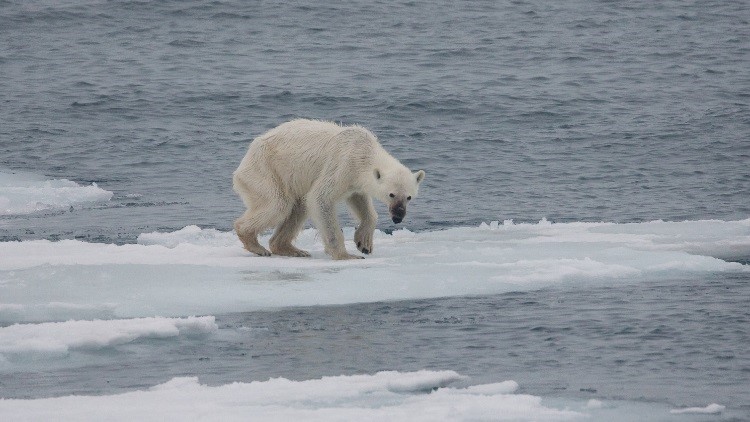
Figure 2
On top of the concern of a food shortage, many negative health effects are a result of climate change. Allergens, vector-bone infectious diseases, cardiopulmonary and gastrointestinal tract issues are some of the many adverse health effects related to global warming (Franchini and Mannucci, 2015). Due to the increase in temperature, infection rates increase as well, resulting in a higher risk of diseases such as, typhus, malaria and West Nile virus infection (Franchini and Mannucci, 2015).
However, not only is the climate change affecting humans, it also impacts the animals. Figure 2 depicts a malnourished polar bear due to loss of habitat as a result of the melting ice caps. The release of greenhouse gases and deforestation causing the change is ruining many species habitats, as well as basic survival needs such as their source of food and water (WWF, n.d).
Impact on Canada
Although some climate change affects such as tropical storms, are not as intense in Canada compared to some other countries, Canada has also recently experienced the damaging effects of global warming. A recent study by Environment and Climate Change Canada concluded that Canada’s temperature has increased at a rate two times the global rate and the northern part of the country at an alarming three times the global average (Ward, 2019).
In northern Canada, glacial retreat and flooding leading to Atlantic sea levels rising has become an issue (Schindler, 2001). Central Canada has become prone to droughts, causing a variety of other issues (Schindler, 2001). Figure 3 shows the massive Fort McMurray forest fire outbreak that occurred in Alberta in 2016 as a result of extreme drought.
Also, with the increasing population densities, the freshwater supply is becoming another concern, affecting both the quantity and quality of the great lakes (Statistics Canada, 2001).

Figure 3
Impact on Agriculture
Livestock
Increasing temperatures are the biggest threat to livestock production. The heat impairs the growth, yield and quality of the product produced by livestock (Nardone et al., 2010). Warmer climates also create the ideal atmosphere for bacteria to breed and thrive, increasing the chance of disease to spread from animal-to-animal. Another major concern is the negative effect it has on the reproductive performance, immunity and overall health of the livestock (Nardone et al., 2010).
With the decrease in crop projection due to the extreme weather, farmers will struggle to feed their livestock as the prices will increase, while their yields will decrease (Nardone et al., 2010). In particular, milk production is highly dependent on temperature. When dairy cows are unable to dissipate enough heat to maintain a stable body temperature, they undergo heat stress (Chase, n.d). Heat stress directly lowers milk production, decreasing productivity by 10-25% (Chase, n.d). With current milk prices, a decrease in production of 10 pounds would cost a farmer $1.50 loss per cow a day (Chase, n.d).
Crop Production
A good crop yield requires adequate levels of nutrients and water to allow plant to grow optimally. On account of the increasing water shortage, many fields are lacking the moisture required for the crops to grow. On the other hand, other areas are experiencing an excess amount of water, resulting in runoff, flooding and soil erosion.
Figure 4 shows the damage a field undergoes when affected by the soil erosion as a result of too much precipitation. This loss of nutrients in the soil erosion leads to soil infertility, reducing crop yield (Nardone et al., 2010). Elevated temperatures and inconsistent precipitation patterns will also harm crop yield (DaMatta et al., 2010). Higher carbon dioxide environments are expected to decrease food quality because it is the source of a decrease in protein, mineral nutrient concentrations and modified lipid composition (DaMatta et al., 2010).
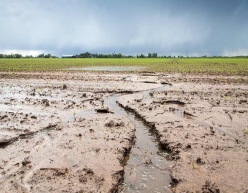
Figure 4
PART 2: PRODUCT DESCRIPTION
What is Nitropit?
Urea is one of the main components of urine and is often used as a nitrogen fertilizer. When farmers spread manure onto their fields as fertilizer, the urea goes through hydrolysis when the enzyme urease is activated (Bittman et al., 2014). This increases the pH of the soil, resulting in a loss of ammonia, which through nitrification, causes a release of nitrous oxide into our environment (Robertson and Groffman, 2007).
Through these natural chemical reactions occurring, a large quantity of these substances are evaporated, creating greenhouse gases, such as nitrous oxide (Robertson and Groffman, 2007). This occurs as a result of the urea being hydrolyzed occurring before the substances have the chance to be absorbed into the soil (Robertson and Groffman, 2007). Ammonia losses as a result are as high as 16% of the nitrogen applied worldwide and even up to 40% in warmer climates (Cantarella et al., 2018)
Nitropit is the solution to this issue. It is a way to lower the greenhouse gas emissions of nitrous oxide created from ammonia losses while spreading manure on fields. Nitropit is a system that can be incorporated into manure pits that releases the urease inhibitor into manure pits in dairy farms so that when farmers go to spread manure as fertilizer, it already contains plenty of the urease inhibitor.
This application of urease inhibitors into the manure will inhibit the enzyme responsible for the reaction and decrease the rate of the urea being hydrolyzed, thus giving the substances more time to be absorbed into the soil. Figure 5 illustrates how the urease inhibitor blocks the urea from binding to the urease enzyme, therefore stopping or slowing the reaction.
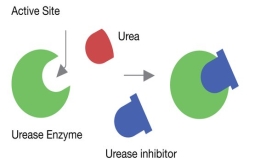
Figure 5
Impact of Current Agriculture Practices
Through using Nitropit, current agriculture practices will not be altered. Farmers can still use all the same techniques and equipment they would have previously when spreading manure. The only new aspect would be simply having an added system onto the manure pit in the barn.
Novelty to Canada
Urease inhibitors have been on the market for the past couple of decades; however, they have all been additives to fertilizers or sprayed on the surface of the fields (Li et al., 2015). A manure pit like Nitropit that has a controlled system to add the urease inhibitors would be a novelty to Canada.
A company who makes the urease inhibitor named Limus was started just two years ago (Li et al., 2015). Limus has been proven to be the most effective urease inhibitor so far, with research proving that a formulation of NBPT (N-(n-butyl) triphosphoric triamide) mixed with NPPT (N-(n-propyl) triphosphoric triamide) is one of the best urease inhibitors (Li et al., 2015). However, Limus has not yet been used in Canada, only in some areas of the United States.
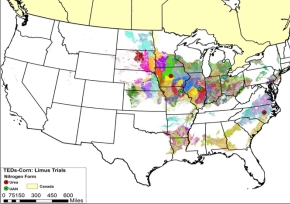
Figure 6
Figure 6 above shows all the current locations that Limus has been tested.
What the Limus Made of?
Limus is a formulation of 16.88% NBPT (N-(n-butyl) triphosphoric triamide) mixed with 5.63% NPPT (N-(n-propyl) triphosphoric triamide) (NutrientStar, n.d). NPPT is a newer inhibitor made by BASF. NBPT is manufactured in the European Economic Area at about 100+ tonnes per year (ECHA, 2019).
How Will Nitropit Benefit Agriculture?
Nitropit will be a huge benefit to agriculture through helping stop the climate alterations that are harming production, as well as keeping the necessary nutrients in the soil for crops to consume. The urease inhibitor would drastically decrease the ammonia losses from vaporization, meaning more of the nitrogen needed for the optimal plant growth would be left to absorb into the soil, benefiting the plant.
Figure 8 shows the financial advantages of crop production through the use of urease inhibitors. Nitrogen is an essential substance needed for plant growth because of its major role in chlorophyll, the organelle responsible for using sunlight, water and carbon dioxide to create the sugars used for energy, known as photosynthesis (Mosaic, 2019).
Figure 7 demonstrates how chlorophyll is a very important part of photosynthesis in a plant. Nitrogen also plays a vital role in the creation of amino acids, which are essential building blocks for life (Mosaic, 2019). Therefore, having more of the substance available to the crops would increase agriculture production in Canada, as well as limit our production of greenhouse gases.

Figure 7

Figure 8
How Will it Benefit Climate Change?
Nitropit will largely reduce the amounts of nitrous oxide and ammonia being released from fields. This will help with the current high levels of greenhouse gas contribution as a result of fertilizers being evaporated. Livestock, especially cows, produce large amounts of urine, containing the urea responsible for this release of nitrous oxide. Therefore, having Nitropit in many farms to decrease ammonia and nitrous oxide would not only be beneficial to the farmer and all of agriculture, but our entire planet’s climate change complication as well.
Safety Training for Use of Limus in Nitropit
The application instructions Limus suggests when using their product are as follows:
- Wear proper personal protection including eye protection and chemical-resistant gloves (O-BASF, 2019).
- Use only under adequate ventilation with large volumes of air movement. If ventilation is inadequate, respiratory protection is required (O-BASF, 2019.
- Fill tank with half the desired amount of UAN (O-BASF, 2019.
- Measure the desired quantity of Limus (O-BASF, 2019.
- Add the Limus and mix thoroughly. Once it is well mixed, other products can be added (O-BASF, 2019.
- Continue mixing while adding the remaining UAN (O-BASF, 2019.
PART 3: THE CONSUMER MARKET
The Current Market of Urease Inhibitors
The growing concern of climate change as well as the increasing awareness of different forms of agriculture are all factors leading to the increasing market of urease inhibitors (Furion analytics Research & Consulting, 2019). Major companies in the industry including, DowDupont, BASF SE, and Solvay SA have all experienced the increasing consumer demand for urease-inhibiting products (Furion analytics Research & Consulting, 2019). BASF, one of the largest companies involved in the production of fertilizers, has recently released Limus, a formulation of NBPT and NPPT, the formulation has shown excellent results since its release date.
Sales of NBPT products, also known as urease inhibitors, have increased by 16% over the past decade and are expected to continue following that trend (Ramspache, 2017). Data has been studied predicting that the market of nitrification and urease inhibitors market is expected to grow at a compound annual growth rate of 3.26% from the years of 2018 to 2023 (Furion analytics Research & Consulting, 2019). Overall, increasing awareness of the environment and the growing focus on higher yields have been driving the market in positive directions (Furion analytics Research & Consulting, 2019).
Find Out How UKEssays.com Can Help You!
Our academic experts are ready and waiting to assist with any writing project you may have. From simple essay plans, through to full dissertations, you can guarantee we have a service perfectly matched to your needs.
View our academic writing services
Who Will Nitropit Benefit Most?
Nitropit will benefit both the farmer profiting from the crop, as well as everyone on earth impacted by the increasing global warming. Studies have been conducted proving that urease inhibitors decrease ammonia losses by 57%, from 54 pounds an acre to only 22 pounds (Isaacs, 2017). This excess nitrogen available for plant consumption allowing better yields is equal to $1,900 worth of savings per 100 acres (Isaacs, 2017). Figure 9 shows the increase in yield comparing many of Agrotain’s fertilizers, including their urease inhibiting products. Even more astounding, when using urease inhibitors combined with UAN (a solution of urea and ammonium nitrate in water), the decrease of ammonia losses is as high as 97% (Isaacs, 2017). On top of the amazing effects urease inhibitors have on decreasing ammonia loss rates, they also decrease nitrous oxide emissions by 21% (Isaacs, 2017).
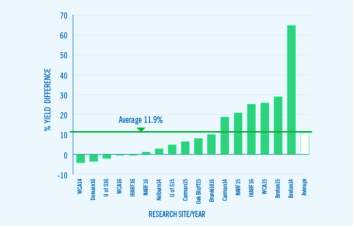
Figure 9
Selling to Companies
Nitropit is an individual product that must be combined with another product, urease inhibitors, that are made through other companies. Therefore, the goal for the optimal results of Nitropit would be through collaborating with a urease-inhibitor-producing-company. By combining Nitropit with large companies such as Limus and Agrotain, it would be more beneficial for consumers to purchase the urease inhibitor needed for their Nitropit.
Who Would be the Greatest Market?
The greatest market would likely be dairy farmers since cows produce the most manure, as well as eat the most so dairy farmers generally are the ones spreading more manure onto their fields. Thus meaning, they would benefit most from the yield increase and greenhouse gas decrease. Another large market would be governments, in many countries like Germany, they are passing environmental regulations as of 2020 stating that all urea fertilizers that are used on fields, must be either incorporated directly into the soil, or used with urease inhibitors (Ramspache, 2017). The major countries for the market of urease inhibitors include, Canada, the USA, Germany, France, China and even some parts of Africa (Furion analytics Research & Consulting, 2019).
PART 4: COST ANALYSIS
Cost of Current Urease Inhibitors
How much would Nitropit be?
i) Inputs required
Labour required
Canadian government financial aid
Storage
Limus showed best results when stored between the temperatures between 54 degrees for 14 days, as well as 14 days at a temperature of -10 C (Gomez et al., 2017)
Transportation
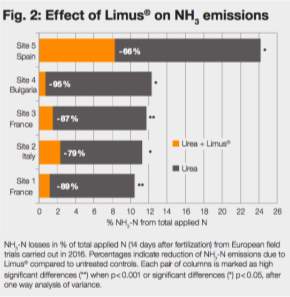
Marketing strategies
Nitropit is a solution to changing our ways to better the environment and the farmers.
Our planet is slowly being destroyed, and we must take action. Ammonia is a toxic solution that causes damage when released into aquatic environments, as well as adding more greenhouse gases into the atmosphere. Greenhouse gases are one of the main causes of global warming, resulting in extreme weather such as droughts that are negatively impacting agriculture production.
Canada would benefit from the use of this agriculturally and environmentally.
The Canadian government has a program that is a part of the Low Carbon Economy Fundraiser called the Low Carbon Economy Challenge where Canadians can apply with ideas and solutions to reducing greenhouse gas emissions (Government of Canada, 2019). This program is searching for ideas like the manure pit that reduced greenhouse gases and funds these solutions.
References
https://climate.nasa.gov/causes/
https://www.epa.gov/ghgemissions/global-greenhouse-gas-emissions-data
https://climateatlas.ca/climate-change-basics
https://www.sciencedirect.com/science/article/pii/S0953620514003628
https://www.worldwildlife.org/threats/effects-of-climate-change
https://www.sageadvisory.com/debatable-yet-undeniable-taking-responsibility-for-climate-change/
https://onlinelibrary.wiley.com/doi/full/10.1111/j.1366-9516.2005.00153.x
https://www.cbc.ca/news/canada/calgary/climate-change-report-federal-government-alberta-1.5080644
https://www.sciencedirect.com/science/article/pii/S1871141310000740
https://www.fwi.co.uk/arable/land-preparation/soils/advice-on-reducing-soil-erosion-in-arable-fields
https://www.bitlanders.com/blogs/structure-and-function-of-chlorophyll/224894
https://www.sciencedirect.com/science/article/pii/S0963996909003421
https://agriculture.basf.com/en/Crop-Protection/Limus.html
http://nutrientstar.org/tool-finder/limus/
https://echa.europa.eu/substance-information/-/substanceinfo/100.103.392
https://www.cropnutrition.com/efu-nitrogen
http://www.cdms.net/ldat/ldC6J004.pdf
https://www.industryarc.com/Report/18613/nitrification-and-urease-inhibitors-market.html
https://www.topcropmanager.com/nitrogen-inhibitors-help-reduce-volatilization-losses-19865/
Cite This Work
To export a reference to this article please select a referencing style below:


